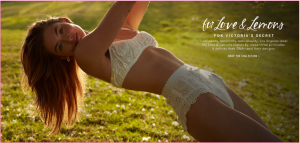Original Ad:

Brief Analysis of the Original Ad:
At first glance, the advertisement seems harmless enough. This advertisement features a pretty girl, who is basically the poster child of beauty. Surrounding the image, the taglines and text appear to induce a nice message that embraces “Confidence, Femininity, and Individuality”. This tagline, or three principles, as the ad calls it, on top of the photo of the young woman subtly portray a message that has been blasted for decades in pop culture and mainstream media; the Western beauty “ideal”.
Like the Victoria’s Secret brand as a whole, the underlying messages in this advertisement are extremely subtle, which may be done intently. Almost to say “this is the way to look, we shouldn’t have to elaborate” (Mull, 2018). Upon dissecting the meanings and the values of this advertisement further, numerous issues revolving dominant views of femininity, age, size and race are uncovered. This silent idealism perpetuates feelings of inferiority and judgement unleashed on parties that don’t necessarily align with the societal mould.
The young woman featured is beautiful, I think she is beautiful, you think she is beautiful, society thinks she is beautiful.
Why is she beautiful?
Is it her blue eyes, or is it her long, straight blonde hair? Is it her youthful, wrinkle-free figure, or is it her slim waist?
The ethnocentric underlying messages behind this ad portray that white is beautiful. However, the colour of your skin is not enough, as one must also understand that thin is beautiful. On top of this, ageist expectations like youth is beautiful, and “feminine” pressure tells us that ladylike is beautiful, refined is beautiful, graceful is beautiful… and the list goes on. Most importantly, the advertisement in its complete raw message is selling perfection or at least the dominant image of perfection. Only if you match these standards, will you be identified fully as a “confident, female individual”. Why? It’s in the DNA.
In my jammed alteration of the original ad, I would like to highlight these unrealistic expectations. I plan to subvert the brand name, as well as redefine the taglines to emphasize the subtext and true harm that can be associated with the advertisement. By addressing the underlying size-ism, ageism, and lack of diversity within the ad, I hope to bring attention to the unrealistic, never-ending criteria the Western beauty “ideal” entails.
Jammed Ad:

Brief Explanation about the Jammed Ad:
In my jammed version of the ad, I redefined the meanings of the underlying messages. To allow for a mocking tone and preserve the traditional implications of culture jamming, I kept the original structure. I chose replacement words that I believed represented the subtext behind the taglines.
From “Confident”, I extracted “Sexy”, as a way to highlight the femininity and patriarchal issues behind the implication. As subtly defined in pop culture, a woman being confident is often reduced to a woman being sexy. Certain implications of “Sexy” can imply derogatory culture and can assume women are inferior to men.
Secondly, I replaced “Feminine” with “Thin”. In definition, femininity is a socially constructed term that incorporates characteristics of women as a whole. These traditionally “feminine” traits include delicate, petite, and gentle. However, these traits certainly do not cover all females. I chose “Thin” in the jammed version as it aligns with the feminine traits I listed above and brings to light the issue of weight and size in regards to “femininity”. To match the ideal standard of beauty, girls must be a certain height, size, and weight: only a few of the requirements to match toxic ideals.
Lastly, I used “White” as a replacement for “Individuality”. Like the issues revolving around the current Black Lives Matter Movement, in Western beauty “ideals”, often one must be “White” to be recognized fully as an individual.
As a play on words, I changed “Victoria’s Secret” to “MY Secret”, to allude to the young woman in the ad being Victoria: the “it girl”. With this symbolism, I suggested that being Blonde and Beautiful, as well as Sexy, Thin, and White, are just part of Victoria’s DNA. Again, with the “if you look like me”, I highlight all the criteria one must fulfil to be considered on par with Victoria, the ideal standard of Western beauty.
With the jammed ad, I aspire to bring to light the ridiculous and damaging expectations for female beauty that are often physically impossible. “[The] pressure on women and girls to strive for the Western beauty “ideal” is replacing the great diversity of human bodies and beauty” (Mckay et al, 2018). Through the alteration, I strive to invoke the deconstruction of toxic ideals by promoting all standards of beauty. To do so, we must rid the dangerous fantasy associated with the current one-size-fits-all implication of beauty.
References:
Mckay, A., Moore, S., & Kubik, W. (2018). Western Beauty Pressures and Their Impact on Young University Women. International Journal Of Gender & Womens Studies, 6(2). doi: 10.15640/ijgws.v6n2a1
Mull, A. (2018, December 3). Victoria’s Secret Has a Mean-Girl Problem. Retrieved from https://www.theatlantic.com/health/archive/2018/12/victorias-secret-proves-brands-cant-be-negative-now/577210/
Stevens, J. (2018, November 22). Starvation diets, obsessive training and no plus-size models: Victoria’s Secret sells a dangerous fantasy. Retrieved from https://www.theguardian.com/lifeandstyle/2018/nov/22/victorias-secret-show-angels-lingerie
Victoria’s Secret. (2020). For Love & Lemons collection. Retrieved from https://www.victoriassecret.com/